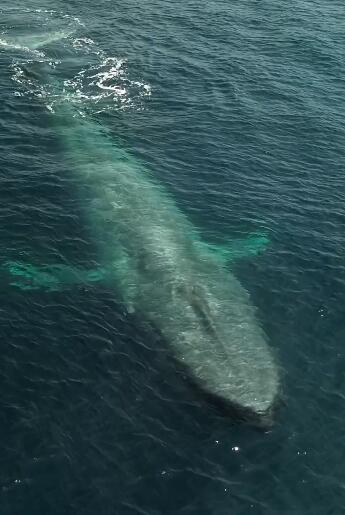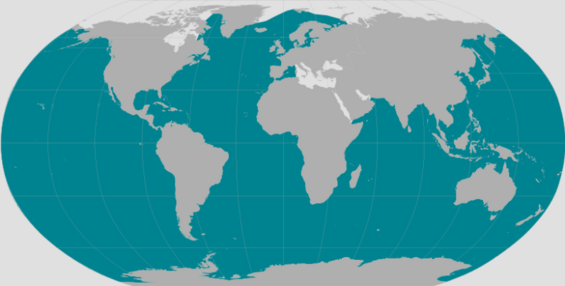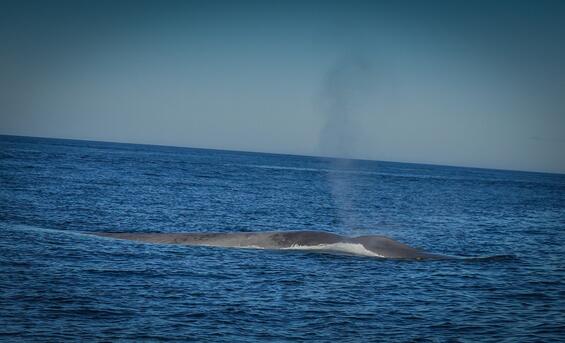- Scientific name: Balaenoptera musculus
- Species of Greatest Conservation Need (MA State Wildlife Action Plan)
- Endangered (MA Endangered Species Act)
- Endangered (US Endangered Species Act)
Description
Blue whale off the coast of Massachusetts.
The blue whale has a long, mottled, blue-gray body, which appears a light blue color under water (NOAA 2025). They have a broad rostrum and large ridge that extends from the blowhole to the rostrum’s tip. Blue whales are reported to weigh up to 150 metric tons (165 tons) and measure up to 33.5 m (110 feet) depending on their location (larger whales reside in the Antarctic). As with most baleen whales, females are usually larger than males. Both sides of the head are dark, and the baleen is black. The dorsal fin is located three-quarters of the way down the body and is relatively small, usually less than 25 cm (10 inches) in height.
Life cycle and behavior
Blue whales can be found in small groups but are more commonly found alone or in pairs (NOAA 2025). They feed in polar waters in summer and then migrate to waters near the equator to overwinter. Swimming speeds can vary from 8 kph (5 mph) while feeding to 32 kph (20 mph) for short sprints. They are one of the loudest animals on the planet; their groans and moans can be heard underwater by other animals as far as 1610 km (1000 miles) away. It is thought that their vocalizations are used for communication as well as sonar-navigation.
Blue whales live 80-90 years. Female blue whales become sexually mature at approximately 5-15 years old. Gestation is thought to last 10-12 months. Calves weigh between 2,300 and 2,700 kg (5,000 and 6,000 lbs) and are about 7 m (23 ft) long at birth. After 6 to 8 months, a calf is about 16 m (52 feet) in length and consumes 350 to 400 liters (92 to 106 gallons) of milk a day. Weaning likely occurs during winter migrations.
The diet of adult blue whales consists mainly of krill and they can keep up to 6 tons in one day. While the whales may also eat fish and copepods, they are not a significant part of the diet.
Population status

Blue whale at the surface.
The blue whale is listed as endangered under both the federal and state Endangered Species Acts. From the late 1800s to 1960, blue whale numbers decreased significantly due to commercial whaling worldwide. Although blue whales received complete international legal protection from commercial whaling in 1966 under the International Convention for the Regulation of Whaling, the population is still recovering slowly.
Distribution and abundance
Populations occur in all oceans except the Arctic, but the distribution of some groups vary seasonally while some groups may not migrate at all (NOAA 2025). Blue whale populations in the North Atlantic, North Pacific, and Southern Hemisphere do not mix. Although the winter distribution of blue whales in the North Atlantic is not well known, their range extends from the subtropics to the Greenland Sea. They are most frequently sighted off the coast of eastern Canada and in the Gulf of St. Lawrence throughout the summer and fall. There are rare sightings off Cape Cod which is at the southern edge of the blue whale’s feeding range.
Blue whale sightings are characteristically very rare in New England; however, they can be seen off the coast of Cape Cod and in the Gulf of Maine. They may feed off the coast of Cape Cod throughout the summer and fall. There have only been a few sightings within state waters. They enter the Gulf in March when the ice breaks up and remain until December and sometimes into January. They have been seen in the winter south of Virginia and north of the West Indies in February and April. Individuals have been seen in Massachusetts waters and nearby in at least May, August, September, and October.

Approximate range of the blue whale (NOAA Fisheries)
Habitat
Blue whales are found throughout the world’s oceans except the Arctic. They are seldomly seen off the shelf waters of the eastern United States (NOAA 2025).
Healthy habitats are vital for supporting native wildlife and plants. Explore habitats and learn about conservation and restoration in Massachusetts.
Threats

Blue whale spouting at the surface.
The primary threats to blue whales are vessel strikes and fishing gear entanglement, both of which can result in injury, reduced reproductive success, and mortality (NOAA 2025). Additionally, ocean noise, pollution, and climate change are thought to also stress blue whales but are less understood.
Conservation
The National Oceanic and Atmospheric Administration has published a blue whale recovery plan. Major management recommendations are to:
- Coordinate federal and international measures to maintain international regulation of whaling for blue whales,
- Determine blue whale taxonomy, population structure, occurrence, distribution, and range,
- Estimate population size and monitor trends in abundance,
- Identify, characterize, protect, and monitor habitat important to blue whale populations,
- Investigate human-caused potential threats and, should they be determined to be limiting blue whale recovery, take steps to minimize their occurrence and severity, and
- Maximize efforts to acquire scientific information from dead, stranded, and entangled or entrapped blue whales.
All stranded whales should be reported to the IFAW Marine Mammal Rescue and Research in Cape Cod at 508-743-9548 or the National Marine Fisheries Service at 866-755-6622.
References
National Marine Fisheries Service. 2020. Recovery Plan for the Blue Whale (Balaenoptera musculus) – First Revision. National Marine Fisheries Service, Office of Protected Resources, Silver Spring, MD. 118 pp.
NOAA [National Oceanic and Atmospheric Administration]. 2025. Species directory: Blue Whale Conservation and Management. Available at: Blue Whale: Conservation & Management | NOAA Fisheries. Accessed on 7/4/25.
Contact
| Date published: | July 7, 2025 |
|---|